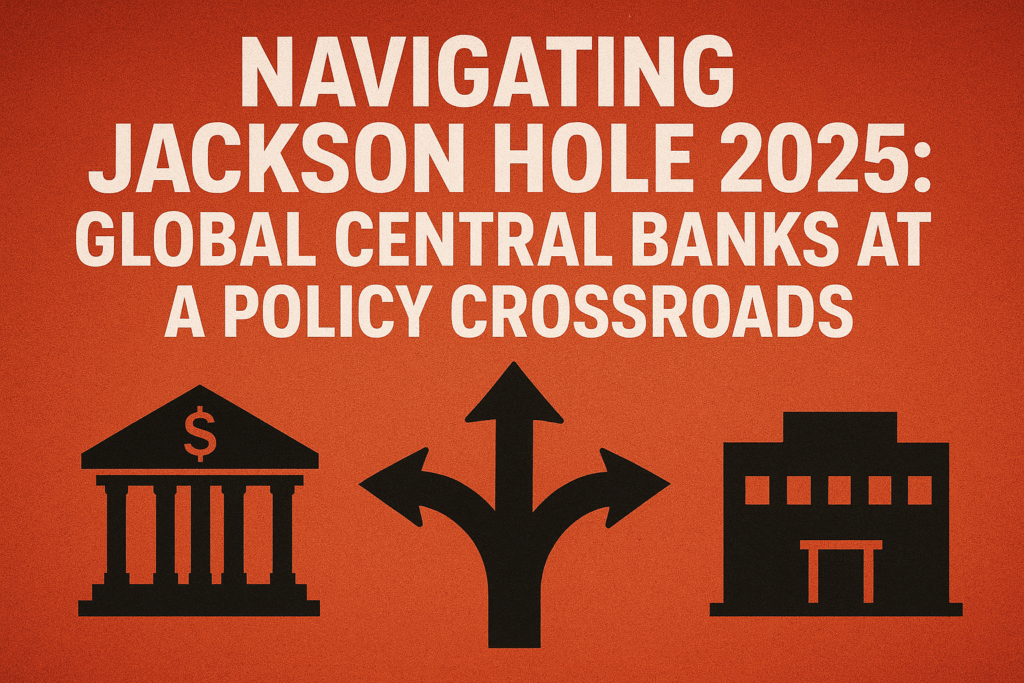The 2025 Jackson Hole Symposium is set to be a historic turning point. Dive into our preview of the key themes, policy debates, and market implications as the world’s most powerful central bankers gather at this global economic policy crossroads.
Introduction: The World’s Most Exclusive Economic Summit
Tucked away in the majestic Grand Teton mountains of Wyoming, the Federal Reserve Bank of Kansas City’s annual Economic Policy Symposium in Jackson Hole is more than just a conference. It is the undisputed heavyweight championship of economic discourse. It’s where the world’s most powerful monetary policymakers—from the Fed Chair to the ECB President—step out from behind their podiums and engage in the raw, unfiltered debate that shapes the global financial landscape for the year ahead.
The 2025 edition is poised to be one of the most critical gatherings in its history. The post-pandemic inflation fire may be dampened, but the structural damage to the global economy is now clear. Central banks are no longer fighting a single enemy; they are navigating a complex battlefield of conflicting data, geopolitical fractures, and untested new paradigms.
This article is your essential guide to navigating Jackson Hole 2025. We will explore the profound questions on the agenda, analyze the key players, and decode the Delphic language of central bankers. More importantly, we will provide a strategic framework for investors, business leaders, and policymakers to understand the monumental decisions made at this policy crossroads and their implications for markets and the global economy.
Chapter 1: The Legacy of Jackson Hole – More Than Just a Meeting
To understand the gravity of the 2025 symposium, one must appreciate its history. Jackson Hole is not where announcements are made; it’s where ideas are launched.
- A Stage for Paradigm Shifts: In 2012, then-ECB President Mario Draghi’s absence was more telling than any speech; he was busy preparing the “whatever it takes” plan to save the Eurozone. In 2020, Jerome Powell unveiled the Fed’s monumental shift to “Average Inflation Targeting,” signaling years of ultra-low rates.
- The “Un-Meeting” Atmosphere: The informal setting—hiking trails, casual lunches, and no press conferences—allows for genuine intellectual exchange. The most market-moving insights are often gleaned from off-the-cuff remarks and nuanced shifts in tone rather than from prepared texts.
- A Global Audience: While a Fed event, Jackson Hole attracts a who’s who of global finance: central bankers from the ECB, BOE, and BOJ; Nobel laureates; leading academic economists; and a select group of private-sector thinkers. The consensus forged here often becomes the global monetary policy consensus.
The 2025 symposium inherits this weighty legacy at a time when the global economic order feels particularly fragile, making the stakes higher than ever.
Chapter 2: The State of Play – The Global Economic Landscape in 2025
The world central bankers will survey in August 2025 is one of fragmented and uneven recovery, presenting a complex puzzle.
The Inflation Picture: Mission Accomplished?
By mid-2025, headline inflation in the US and Europe is expected to be much closer to the sacred 2% target. However, the “last mile” of inflation fighting has proven treacherous. The debate will have decisively shifted from containing inflation to understanding its new structural drivers:
- Deglobalization and Geopolitics: Reshoring, friend-shoring, and trade tariffs have introduced a persistent “geopolitical premium” on goods, making them structurally more expensive than in the hyper-globalized pre-2019 era.
- The Green Transition: The massive capital expenditure required for the shift to renewable energy is inherently inflationary in the short-to-medium term.
- Labor Market Rigidity: Demographic decline in advanced economies and a skills mismatch create sustained wage pressure, particularly in service sectors insulated from global competition.
The Growth Conundrum: Soft Landing or Stagnation?
The great “soft landing” hope of 2023-24 will have either been realized or dashed. Key questions will dominate:
- The US: Has the economy settled into a slower, but stable, growth path, or is it hovering on the brink of stagnation, kept alive only by residual fiscal stimulus?
- The Eurozone: Has the manufacturing powerhouse of Germany emerged from its slump, or is the continent facing a prolonged period of Japan-style secular stagnation?
- China: The biggest wildcard. How is the ongoing property crisis and demographic shift impacting global demand, supply chains, and commodity prices? The health of the Chinese economy will be a shadow topic over the entire symposium.
Chapter 3: The Great Policy Crossroads – The Core Debates for 2025
This is the heart of the matter. The 2025 Jackson Hole symposium will be defined by three monumental debates, representing a true policy crossroads for the global economy.
Debate 1: The Neutral Rate (R-Star) Reassessment
The most critical and technical discussion will revolve around the neutral rate of interest (R). This is the theoretical goldilocks rate that neither stimulates nor restrains the economy. The entire pre-pandemic monetary policy framework was built on the assumption that R was very low (around 0.5%-1% in real terms).
The Question for 2025: Is R* permanently higher now?
- The Case for a Higher R*: Proponents will argue that the structural shifts mentioned above—degLOBALization, large fiscal deficits requiring debt financing, and the green transition—have increased the underlying demand for capital and thus pushed the neutral rate up. This would mean policy has not been as restrictive as thought, and central banks can hold rates higher for longer without breaking the economy.
- The Case for an Unchanged Low R*: Others will contend that powerful disinflationary forces (technology, AI, aging populations) will reassert themselves once current shocks pass. They will warn that keeping rates too high for too long based on a misjudgment of R* could trigger an unnecessary and deep recession.
Why it Matters: The conclusion on R* will dictate the entire pace and endpoint of the global rate-cutting cycle.
Debate 2: The New Fed (& ECB) Toolkit – Quantitative Tightening (QT) and Forward Guidance
The era of bloated central bank balance sheets is over. The new debate is about their optimal size and composition.
- The QT Endgame: How far can the Fed and ECB unwind their balance sheets without causing liquidity crunches (a la September 2019) or disrupting bond markets? Jackson Hole 2025 will be the forum to signal a slowdown or a defined endpoint for QT, a move as significant as a rate cut for market functioning.
- The Future of Forward Guidance: The practice of pre-committing to future policy paths was shattered by the inflation surge. Central bankers were forced to pivot abruptly, damaging their credibility. The 2025 discussion will focus on a new, more data-dependent, and less specific form of guidance, moving away from rigid calendar-based promises.
Debate 3: The Limits of Mandates – Should Climate Change and Inequality Be a Central Bank’s Problem?
This is the existential debate. The traditional mandate is price stability and maximum employment. But powerful voices argue that in a world of climate shocks and social unrest, central banks cannot ignore their role.
- The Green Mandate Push: Should the ECB’s corporate bond-buying program favor “green” companies? Should the Fed incorporate climate risk stress tests into its bank supervision? This topic creates deep divisions between progressive and conservative policymakers.
- Inequality and Distributional Effects: Quantitative Easing (QE) inflated the assets of the wealthy. Rapid rate hikes disproportionately hurt younger and poorer debtors. There will be intense debate on whether monetary policy tools should be designed with distributional consequences in mind, or if that is solely the domain of elected fiscal authorities.
Chapter 4: The Key Players – Who to Watch and What They’ll Say
The narrative of Jackson Hole is shaped by its speakers.
- Jerome Powell (Chair, U.S. Federal Reserve): The headline act. The world will parse every syllable for clues on the R* debate and the timing of the next rate move. Will he signal a pause, a pivot, or a permanent shift to a higher-rate regime?
- Christine Lagarde (President, European Central Bank): The ECB is often caught between a weaker economy and lingering inflation. Will Lagarde signal a more dovish path than the Fed, or will she emphasize Europe’s own structural inflation pressures?
- The Academic Vanguard (e.g., Olivier Blanchard, Larry Summers): The intellectual architects. Their papers and presentations often provide the theoretical groundwork for the policy shifts that follow. Watch for any new research on estimating R* or modeling the inflationary impact of deglobalization.
- The Rising Stars (e.g., Governors from newer nations): Often, the most innovative ideas come from central bankers dealing with extreme situations—hyperinflation, currency collapse, or debt crises. Their experiences can offer radical solutions to the developed world’s problems.
Chapter 5: Market Implications – How to Position Your Portfolio
For investors, Jackson Hole is a volatility event and a strategic planning session.
- Foreign Exchange (FX): The relative tone between Powell and Lagarde will drive the EUR/USD pair. A hawkish Fed and a dovish ECB would strengthen the dollar. Signals on the pace of QT are also crucial for dollar liquidity.
- Equities: A consensus on a higher R* would be initially negative for growth and tech stocks, as it implies a higher discount rate for future earnings. A reaffirmation of a low R* would be a bullish signal. Clarity on the QT endgame would remove a major overhang and be positive for market liquidity.
- Fixed Income: Bond markets are hyper-focused on the R* debate. A shift in consensus towards a higher neutral rate would cause a steepening of the yield curve (long-term rates rising faster than short-term ones). This is the single most important takeaway for bond investors.
- Real Estate: The entire sector is rate-sensitive. Any signal that the high-rate environment is permanent will continue to pressure commercial real estate valuations and mortgage rates.
Chapter 6: Beyond the Headlines – Reading Between the Lines
The official speeches are only part of the story. The real art of navigating Jackson Hole is in the interpretation.
- The Vocabulary Shift: Watch for changes in key phrases. Is the economy still “resilient” or is it “cooling”? Is the labor market “tight” or “coming into better balance”? Is policy “restrictive” or “significantly restrictive”? Each adjective is carefully chosen.
- The Dovish Whisper in a Hawkish Speech: Sometimes, the most important line is a single sentence of caution buried in an otherwise upbeat assessment. It can be a trial balloon for a policy shift.
- The Q&A Session: The unscripted Q&A often reveals more than the speech. It’s where policymakers are forced to clarify, defend, and sometimes reveal their true thinking.
Conclusion: The Fork in the Road
The 2025 Jackson Hole Symposium arrives at a moment of extraordinary consequence. The paths chosen by the men and women in that Wyoming conference room will determine the cost of mortgages, the viability of businesses, the returns on investments, and the economic stability of nations for years to come.
They stand at a policy crossroads shaped by the ghosts of pandemic stimulus, the realities of geopolitical fracture, and the uncertainties of technological transformation. The debate over the neutral rate is, at its core, a debate about the very nature of the future global economy.
For those watching, the key is to listen not just for decisions, but for the framework behind them. Jackson Hole 2025 won’t provide a detailed map, but it will give us the compass. Understanding its readings is essential for anyone with a stake in the global economic future. The road from Jackson Hole is the one we will all be traveling down.


